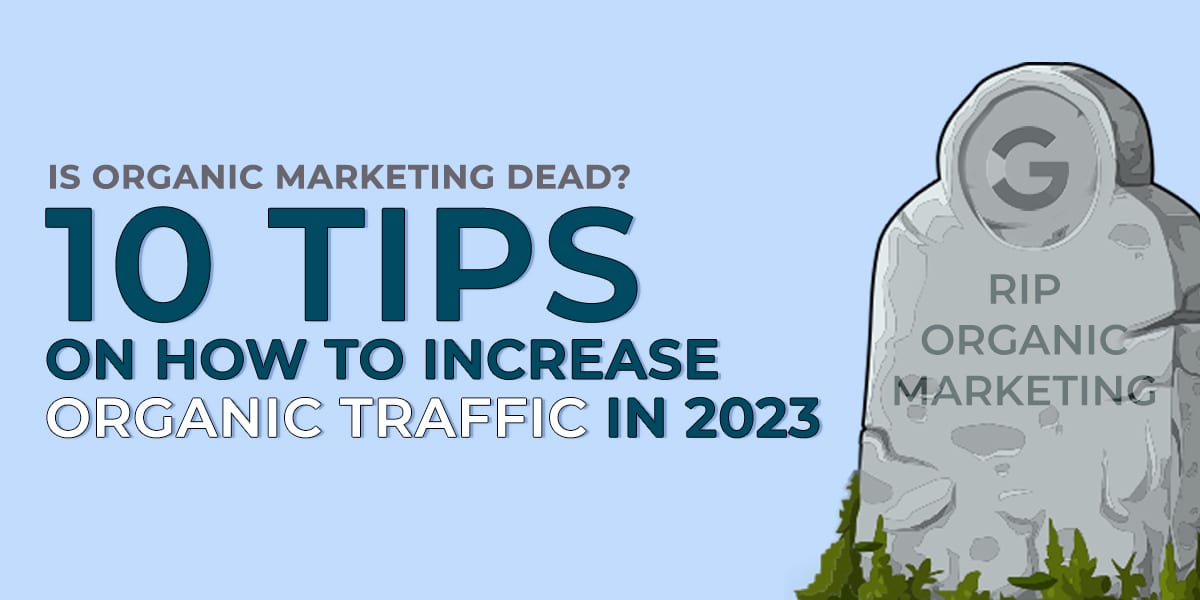Is Organic Marketing Dead? 10 Tips On How To Increase Organic Traffic This Year
How to Increase Organic Traffic This Year For Your Business 101
Is SEO dead in 2023? The short answer is; of course not! As long as people keep using search engines to find what they are looking for, search engine optimization (SEO) will continue to be relevant and necessary for your business to thrive. In fact, ensuring your website is properly optimized to best capture organic search traffic could separate your business from the competition. Even better? Ensuring your website has a strong SEO foundation now will set you up for long-term success with no extra budget required for the future. While organic search marketing is essential, many business owners are lost on how to increase their organic traffic. Interested in how to increase organic search traffic? Read on!
What is Organic Traffic?
Organic traffic occurs when a user finds your website by searching for a term, then clicking on your website from the listings on the search engine results page (SERPs) that are not paid ads. (The first few listings on most SERPs are generally labeled as “Ad.” These are Pay-Per-Click ads, and are not considered organic listings.) The term is called organic search traffic because it indicates that a user found you “organically,” without the help of paid ads. The higher you appear on the SERPs, the more click-throughs to your website you normally get.
Increasing organic search traffic should be top-of-mind for all businesses as it’s the traffic you don’t have to pay extra. If you’re interested in ways to increase organic traffic to your website but are hitting a roadblock, fear not! One of the best ways to boost organic traffic is to really dive into SEO best practices, as this can help you rank higher on search engines to put you in front of more eyes. If growing your website organically sounds overwhelming, read on for some simple tips on how to increase organic traffic to your website.
1. Create a Keyword Strategy
Determine what keywords are going to work well for your business and connect the most with your audience. In order to make a list of the keywords you want to target, you will want to think about how consumers would search for your services or products. While making a list of these keywords, be sure to check the traffic and competition for each term. While looking at keywords, keep relevancy in mind. A keyword may have great monthly search traffic and low competition, but if it’s not particularly relevant to your website’s content, the algorithm isn’t likely to rank you for it. A strong keyword strategy is a vital first step to creating optimized website content that will rank on Google and other search engines.
2. Optimize Page Titles
The title tag, or <title> in HTML code, tells a search engine a short description of what is on that page of your website. It will be what Google first displays, as part of organic search results. Page titles should be concise, less than 70 characters, but also relevant. This is the first thing a user will see when they scroll through search results, so you will want to ensure that your title is clear and accurate to your website and offerings.
3. Write Good Content
Sounds simple enough, right? However, many businesses struggle with creating evergreen content that relates to their audience. This is one of the many ways a digital marketing agency can assist you. Always place quality above quantity, as this will assist in building up your reputation. Users that are searching for your business, including your products and services, want information that will help them in some way. If you are stumped on where to start, think about the needs of your potential customers. Ask yourself what information they might like to know. Content should always be original and never plagiarized, which will hurt search rankings.
4. Integrate Keywords into Your Content
Once you have a keyword strategy in place, you’ll want to start implementing those keywords throughout your website content, including other aspects of your website like title tags and meta descriptions. In years prior, it was thought that putting in as many keywords as you could would help boost you in the algorithm. Today that practice is known as “keyword stuffing” and is not recommended as an SEO best practice. Instead, focus on relevancy when placing keywords. For each page, focus on one primary keyword for the page that you wish to rank for, then select a few secondary keywords to target as well to support your content and keyword strategy.
5. Write Meta Descriptions That Lead to Clicks
Google will display your meta description in the search results right underneath your title. The meta description acts as a short explanation of what can be found on that particular page. Meta descriptions should not only include your primary target keyword for the page but have a compelling call-to-action that entices a user to stop scrolling and click through – so lead with value.
6. Utilize Keywords as Anchor Text for Linking
When you are linking to another page from within the body of text on a particular page, the text that is hyperlinked is referred to as anchor text. Optimizing your anchor text with keywords will help tell the search engine what the linked website is about and help to overall boost your site’s SEO value. While you can use exact keyword phrasing, you can also use close variations of your keywords to prevent overuse.
7. Make Your URLs Readable
Search engines know that your URLs are going to be read by a real person, so creating a confusing or unreadable URL could potentially hurt your search rankings. This includes the URL for every page on your website, so ensure that they are all readable to relate to the content on the page. USe simple, descriptive keywords in all lowercase with dashes in between.
8. Don’t Leave Out ALT Tags
ALT tags are often forgotten about, but they are important for SEO as images also have the potential to rank for keywords. These HTML elements are used to provide alternatives when an image can’t be rendered. Make sure to always place targeted keywords in ALT tags.
9. Create a Link Building Strategy
Link building refers to getting new links to your site from external websites. While you might be creating good content that leads to sharing, you can also guest blog and ask authoritative sites to link back to your page. When creating a link-building strategy, you will want to focus on the domain authority that you are receiving backlinks from, as authority is passed over through links and this can help your ranking.
10. Make Your Website Mobile-Friendly
Mobile optimization does affect your ranking, so it is pertinent that your website is mobile-friendly. Testing out your website on a mobile device is a great place to start. However, the optimization part can get a little tricky. Keep your call-to-action (CTA) buttons accessible and compress images to help with loading times.
How to Increase Organic Traffic Quickly? Partner with N2Q for Your SEO Needs
We understand that you have a lot on your plate as a business owner and learning how to increase your organic traffic just might not make it onto your to-do list. After all, implementing SEO best practices can be overwhelming for one person to take on. However, optimizing your website and driving organic traffic is essential for a complete digital marketing plan. So, let us handle the technicalities. Our dedicated team members take the time to uncover what sets you apart from the competition and how we can fully connect with your audience. Learn more about what N2Q can do to help your business.
SEO No To The Quo



